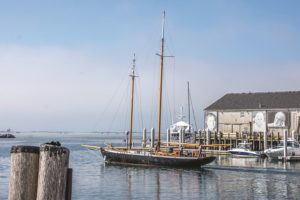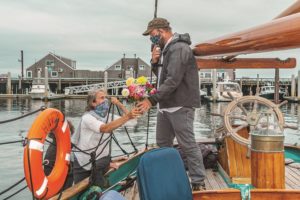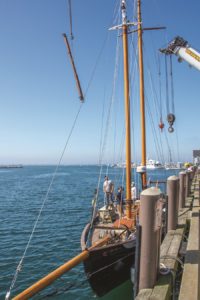PROVINCETOWN — An evening aboard the schooner Hindu, watching the sun slip behind the monument and clouds light up like giant hydrangeas, has been a Provincetown tradition since 1946. Generations of tourists and locals have memories of their time aboard and many residents, including this reporter, have served as crew. If events had gone just slightly differently a couple of Fridays ago, memories are all that would be left of her.
The Hindu and her crew survived a bizarre maritime accident in Long Island Sound on July 10. Only a few feet to the left or to the right, and the freak collision could have sunk her in minutes.
The Hindu was already a living relic — an original wooden schooner built in 1925, the tail end of the era of massive sailing ships and pleasure yachts. Designed by the legendary boatbuilder William Hand Jr., the Hindu is one of only a handful of wooden boats that are still around.

Part of her survival story is her peculiar ownership history. Built as a pleasure yacht with two cabins, she was gutted and retrofitted for crew during the Great Depression, and sailed to India as a commercial vessel. Not long after, the U.S. Coast Guard requisitioned her for the Second World War effort. Though wooden sailing vessels were obsolete, they could run without engine noise, which made them undetectable by German U-boats. Fishing schooners and pleasure yachts were used to hunt for U-boats in 1942 and 1943, calling in the location of periscope sightings to bomber pilots.
After the war, Al Avellar bought the Hindu from the Coast Guard and brought her to Provincetown. Since the Coast Guard had already retrofitted her, the transition to tourism went smoothly. She took passengers on twice-daily harbor cruises, and, on calm days, Avellar would steer his customers out to Stellwagen Bank to see whales — an activity that proved so popular, he started the Dolphin Fleet of whale watch boats.
For 60 years, under a series of owners, the Hindu lived in Provincetown like other year-rounders: working seven days a week in the summer and spending winters bundled up and dry. In 2004, Capt. Kevin “Foggy” Foley and his business partners took the Hindu to Key West, Fla., to work winter seasons. The partnership quickly fell apart, however, and Foley lost the Hindu to a bank in 2009.
While tied up in the courts, she sank at her mooring and was nearly scuttled for scrap. A maritime family in Key West bought her in 2011 and restored her. Now, Capt. Josh Rowan brings the Hindu back to Provincetown every June to sail the summer season in her historic home port.
Collision Course
It was on that annual voyage back to Provincetown that the Hindu nearly met her end. At 3:30 a.m. on the morning of July 10, in more than 100 feet of water in Long Island Sound shipping lanes, the Hindu suddenly jolted as if it had run aground.

“I knew that was impossible,” said First Mate Erin Desmond. “It was my watch. I was looking straight at the instruments, and I knew we were in the center of the channel.”
Capt. Rowan, who was at the helm and looking forward, saw what had happened first. “The bow of a fiberglass yacht rolled out of the water and pointed up at the sky, like a sinking Titanic,” said Rowan. “It stood 12 feet out of the water as we slid past it, and the white hull made it look like a manmade iceberg.” The Hindu passed the “boatberg,” and Desmond, looking towards Rowan at the stern, saw it slide straight down into the ocean and disappear.
Based on where the Hindu made contact, several feet below the waterline, Rowan thinks the sunken yacht was suspended in the water column. He estimates it at 30 to 40 feet long, and with enough air trapped inside it, it would have sunk only a few feet. There were no reports of lost yachts; no one knows how long it could have been drifting with the currents. When the boat rolled and pointed skyward, it could have released its trapped air and sunk for good.
“I called mayday to the Coast Guard and ran down below to check if we were sinking,” said Rowan. The Hindu had struck the submerged vessel square on, with the strong structural parts of the bow bearing the force of the collision.
“It broke the joints of the stem, and several of the hood ends, where the planks tie into the stem,” Rowan said. “We were taking on water, but not so much that the redundant bilge pumps couldn’t handle it. If it had been just a couple of feet over, to the right or left — if it had made first contact with the planking of the hull, rather than the stem — it would have sunk the boat. Quickly. We would have had 5 to 10 minutes before we were in the water, in survival suits.”
The crew of four would have survived — GPS and survival suits make a huge difference, Rowan added. But the Hindu would have been one more wrecked schooner at the bottom of the sea.
Fixer-upper
Rowan had been planning a comprehensive rebuild of the Hindu — “the kind of work that will carry her through the next 100 years,” he said. The front and back of the boat were built to curve upwards, like a saddle or a smile. The Hindu is old enough that the bow and stern both sag downwards. This puts all kinds of problematic pressure and tension on the planking of the hull.

To replace decking, hull, and keel is an enormous undertaking, however. It’s a 12-month project, done entirely by hand, and there’s rarely a good year to forgo an entire year’s income. Covid had Rowan thinking this was the year, and the collision made that an obvious choice.
“We’re taking her to Maine, and working with a legendary shipwright named Mike Rogers,” said Rowan. “Erin and I will do a lot of the organizing and labor and project management alongside him.”
Rowan and Desmond have set up a community fund-raising page on GoFundMe.com. “Promise to the Schooner Hindu” has a $500,000 campaign goal. “None of that is to pay me or Erin,” said Rowan. “That’s for materials, shipwright, shipyard, and journeymen, so that when she turns 100 years old in a few years, she’s in condition to last another 100.”



